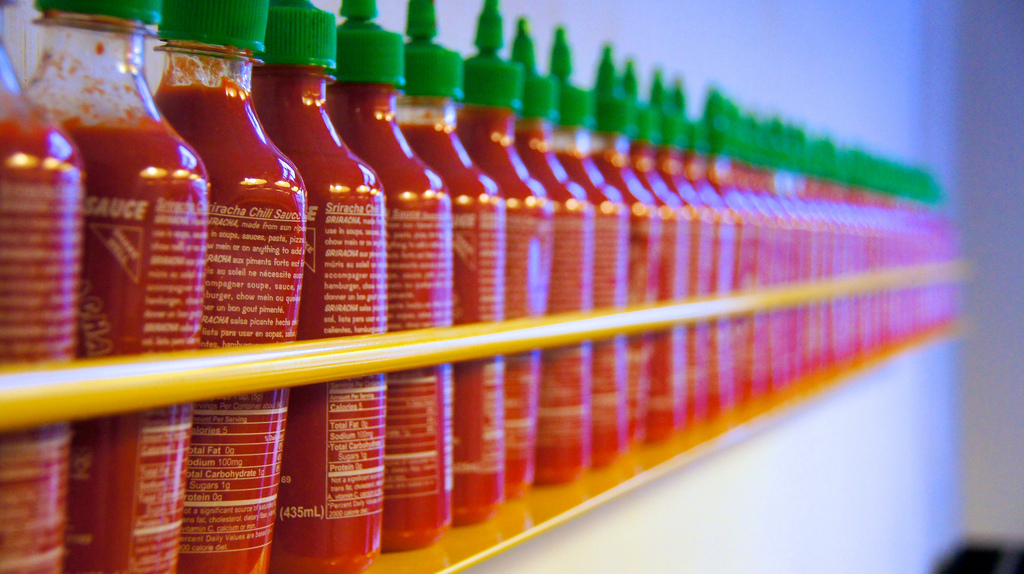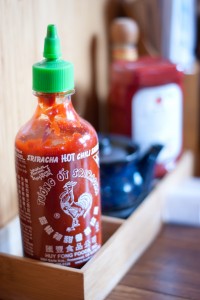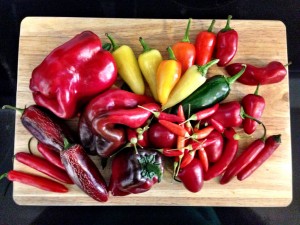Hot Sauce Over Humanity: On Sriracha

Recently, the Internet has been abuzz about the possibility of a shortage of Sriracha, aka Rooster or Cock sauce. Most pieces, even from publications and blogs whose pieces I normally at least somewhat like, relegate what the residents’ complaints are to a parenthetical (literally) reference. It turns out that something truly, sincerely horrible is being glossed over by the breezy, won’t-someone-think-of-the-hot-sauce coverage.
The Oatmeal’s jokes about how gosh-darn delicious it would be to breathe air saturated by the spicy odor notwithstanding, the latest increase in Sriracha production has seriously adversely affected the health of the people living near the factory.
Via CNN’s Eatocracy
According to the complaint filed with Los Angeles Superior Court by the city of Irwindale, the stench of cooking peppers isn’t just unpleasant – it’s painful. Watery eyes, stinging throats and headaches are par for the course, say city officials who have been fielding complaints since the Huy Fong factory kicked up its season’s pepper production.
This isn’t an annoying, spicy odor — I’d call this capsaicin poisoning. If you’re lucky enough to have never experienced what it’s like to have capsaicin directly affect a mucus membrane, I have some stories.
During his Marine training, a friend of mine get maced, a fairly common practice in military and law enforcement. The next day, he was tased. He later received a Purple Heart for getting shot in the clavicle in Iraq. He has told me that he would rather get shot in the clavicle again or tased ten times in a row than maced another time.
A few years ago, I was slicing a pepper when I hit just the right (wrong?) angle with my knife. A gush of serrano juice went straight into my eye. The pain rendered me senseless. I ran around my apartment, writhing and screaming in agony. 30 minutes in the shower and a whole bar of tea-tree oil soap later, my eye looked like it had been punched and felt like it had been repeatedly stabbed. I’ve had multiple surgeries on my diseased knee and, as a nulliparous woman, have had an IUD inserted into me without any anaesthetic — and getting pepper juice to the eye was far more painful than any of those procedures.
People are being harmed by the by-product created by the processing of a condiment — a condiment, not even some kind of essential nutritional staple — and the best most of the coverage has done about it is make oh-so-hilarious puns, jokes, and references to the matter and wring collective hands over the lack of hot sauce.
Why do we care more about hot sauce than people? The answer may lie in some very telling coverage of the matter via Youngist (emphasis mine).
According to the 2010 United States Census, about 90% of Irwindale’s 1,400 person population is of Hispanic or Latino origin, and about 95% is of color. The median household income of Irwindale in 2009 was about $55,000, which was close to the California median. However, during the same year, the median per capita income for Irwindale was at about $17,500, while California’s median per capita income was close to $44,000.
Everything from sub-standard housing conditions to poor urban air quality to reliance on walking and public transit to employment in outdoor or factory work means that the economically disadvantaged are far more exposed to environmental hazards. That the poor, especially those of color, experience the worst of pollution is a well-studied, well-established, uncontroversial phenomenon covered by the American Lung Association and studied by Yale.

It really isn’t much to ask that the Sriracha factory raise its community health and safety standards to match its increase in production. If the company is truly growing in popularity, it will need to continue to revise such standards in the coming years. For now, it’s not really that hard to look for alternatives (Google and your local Asian market are your friends).
What is hard? Looking at your priorities and seeing that they, however inadvertently, are classist and racist to the point of dehumanization.






I should be easy enough to make at home, we can still get pepper spray and turpentine right?
I’d evaluate the “Sriracha factory smells bad” story in the same way as many still view the “woman sues because McDonald’s coffee was hot” story. In both cases, the facts were misunderstood … genuine harm was done. But like the “what do you expect from coffee, dummy?” factor derailed the real facts, and now the “poor crybabies don’t like the smell of this yummy sauce” factor disguises the fact that the neighborhood is literally being pepper-sprayed.
I wouldn’t leap to cry “racism and classism” too quickly. Several important facts were omitted in the initial reporting (neighborhood being maced instead of merely subjected to bad smell, factory ordered closed instead of ordered to eliminate emissions), so the public put the “puzzle with a missing piece” together wrong. Courts have quite reasonably ordered factories to eliminate noxious emissions before, and that should be the beginning and the end of the story.
The public has access to the Internet and could have investigated. They didn’t. The fact that no one reported on the legitimate concerns of a lower-income community of color is classism & racism at work.
I wonder what the result would have been had Irwindale been some kind of WASPy enclave. I have to admit I can easily imagine the complaints being similarly dismissed or ridiculed in the media along the lines of “white people object to smell of ethnic food; sue factory.”
Of course, it’s highly unlikely that a factory would be located near such an enclave in the first place, so there is that.
The NIMBYs are strong around these parts.
“I wouldn’t leap to cry “racism and classism” too quickly”
I would, one doesn’t have to be cognizant of being racist or classist to be such.
So … despite my considered conclusion that it’s too easy to blame this on “racism and classism”, I’m simply too dull to evaluate the issue? Thank you very much.
Well, your “considered conclusion” doesn’t address why important facts were left out of the initial reporting, which could indeed be a result of racism and/or classism. That is kind of the point of this article.
“Could” indeed, but has anyone troubled to trace it back to its earliest report? That might tell us something.
There is no mention of the court case at all in this Oct 21 profile, which went up before the decision.The earliest report I can find is an LA Times article from Oct 28, which clearly cites residents’ specific complaints. These are also present in the AP version of the story. Within a day, however, local and national level publications were leaving this out despite quoting the LA Times / AP articles verbatim (so they presumably knew what was going on).
I also think it’s fairly significant that there seems to be no coverage of this problem before the court decision came down. One might expect some attention earlier on in the process. Is it that media outlets didn’t know about the problem? In an affluent area one might even expect a phenomenon like this to rip through social media long before anything got resolved in the courts.
I used to think like you do about stories like this, but here’s why I think we should leap to the race/class thing MORE often: the problem is that you can look at any single story involving a certain population not being heard and say, “now, let’s not jump right to race/class,” and that’s a reasonable doubt when you’re looking at one case. But once you start to see a pattern, once you see so many cases of unprivileged populations not getting heard while privileged populations do, that doubt becomes not so reasonable anymore.
TL;DR: At first you’re thinking, well, anecdote isn’t data, I better withhold judgment here. But a bunch of anecdotes? That’s data. Time to start judging that shit.
1)Looky, I can log in again :-)
2)Yup, this is a straight-up example of environmental racism.
3)No, it’s not reasonable to tell people not to “leap to cry ‘racism and classism’ too quickly. Is this part of a pattern of communities of color being primarily affected by environmental pollution? yup. Is this part of a pattern of not reporting, under-reporting, or mis-reporting stories about harm to communities of color? yup. Therefore it’s part of the structural force called environmental racism regardless of whether this sometimes happens to white people and their stories, too; because statistical outliers and exceptions are A Thing.
My wife regularly makes delicious hot sauce, but the fumes when she is cooking it can be quite brutal. I can’t even imagine what it would be like to live with that on a daily basis. When the fumes in the house get bad I can open a window or go outside. The folks in Irwindale have no such relief. I hope this can be resolved in a healthy and productive manner for all involved.
I make coffee as well but I would not roast coffee without the appropriate ventilation etc. and the local cafe that roasts its own had to pass pretty stringent tests to get the roaster installed.
This is just a pollution issue and it should not be necessary for residents to bring a case. The city should have shut the factory down already. It is not a NIMBY problem, it is a health and safety you-don’t-get-to-do-that-anywhere issue.
Rather than ascribing racism as the cause I suspect that the issue is that the emissions started small and grew over time. That is also very common in pollution cases.
If a factory can’t be operated safely it gets shut down. It is the manufacturer’s job to work out how to do their business safely and buy the necessary safety equipment. They need to put scrubbers on their exhaust vents for a start. Allowing them to operate unsafely is unfair to the businesses that do the job right.
Racism & classism contributed to the problem of people prioritizing their hot sauce over the well-being of fellow human beings, and they factor into the disregard for industrial pollutants’ effects on people. I did link several studies on the matter.
I agree that the much of the press coverage has that problem. Though the first report I read on the issue was several months back when the case was filed and it covered the story purely from the public health angle.
The obnoxious stuff seems to have been coming from the opinion piece peddlers, ‘oh nasty regulations take away our hot sauce’.
They only moved production to Irwindale this year which means that the authorities were onto them pretty quickly and the problem was pretty bad.
My city has pretty much shut down the light industry apart from a few auto repair and body shops. And the body shops look likely to get squeezed out.
You are right in the general case, I would not want to use this as a proof point.
But it’s not “just a pollution issue”, when the national (and global) patterns of who is affected by pollution are correlated with race. It’s not “just a pollution issue” when stories on it prioritize “hipster” comfort over poisoning. It’s not “just a pollution issue” when as you say the community shouldn’t have had to make a lot of noise about this because it should have been just a basic health and safety issue, and yet their did because their communities are low on class and race privilege.
Again, the different impact of environmental pollution on different racial groups is a real thing; so’s the media silence and downplaying of environmental issues when they are about minority communities. This is part of that pattern. Here, have some more background info on environmental racism (and also read the links Heina provided on this topic):
http://www.dosomething.org/tipsandtools/11-facts-about-environmental-racism
http://www.environmentalhealthnews.org/ehs/news/2012/pollution-poverty-people-of-color-series-summary
http://www.medscape.org/viewarticle/589135
Also, don’t confuse “example of” with “proof of”. Does this story prove all by itself that environmental racism is a thing and how it works? No, because it’s a single story; it illustrates the issue. The issue itself is evidenced by research, some of which Heina linked. Talk of “proof” is completely missing the point here anyway, since this article isn’t meant as proof of environmental racism; it’s meant, AFAICT, as a check on a very privileged framing, meant to re-center it on where it belongs i.e. the people being harmed.
I still think many commenters here are assuming “evil conspiracy” when the facts (regarding the journalism) are adequately explained by laziness and stupidity. Journalism certainly isn’t like I was taught it in college, but then it probably never really was.
As for the business decisions, again, it looks to me like people perceive an evil conspiracy to screw over the poor with a much simpler (and eternal) explanation: money. It’s all, and always, about the money. Do you really think that (or any other) factory site would be chosen unless it was financially advantageous? Whether a business is privately held, or the decisionmakers are responsible to stockholders, generally factories are established where the most money can be made.
Wait, how does exploiting the economic factors of a multiply-disadvantaged population mean it’s not racist or classist? How does a systematic exclusion of information initially available deliberately excluded to reframe a story (note: those last six words are important) make it not classist and racist?
It’s racist and classist in effect, but not in intention. The journalist’s and owner’s intentions are solely to get out an easy and entertaining story, and to make the most money. They don’t, IMO, engineer things with the deliberate intent of preying on the disadvantaged, they don’t care if the people residing near the factory are black, white, polka-dotted or purple, they want the easy story and the quick buck.
No, they aren’t talking about a conspiracy. They are taking about INSTITUTIONALIZED RACISM and CLASSICISM. There is a difference.
Indeed, it’s, in my opinion, worse than a conspiracy — which is far easier to pinpoint and discuss. There’s someone/a group to blame. With institutionalized racism it just IS, and it’s far harder to identify and talk about (as we can see here).
It doesn’t make it any less of a problem nor any less “evil” — indeed, it is worse, because it is inherently lazy and even those of us who work to do better can sometimes get caught up in it without even realizing it (see Rebecca’s comment below).
Racism and classicism stems from greed and laziness ALL THE TIME.
WHY do you think they placed this plant where they did? You said it yourself — because it was financially in their best interest. And do you know where such plants and warehouses are almost *always* placed? IN POORER NEIGHBORHOODS. They are expected to go there — certainly not in the richer neighborhoods. This plant would have *never* been placed in a rich neighborhood. And if it had, and the result had been that it was causing many of the rich residents pain and discomfort, it would have been removed immediately. But it wasn’t place din a rich neighborhood and it never would have been.
You missed the entire point of this article. It has nothing to do with a conspiracy. It has to do with the fact that this sort of institutionalized racism/classicism is the NORM, and people don’t even think about it — it just happens.
“It’s racist and classist in effect, but not in intention. ”
And to reiterate that was the whole fucking point of this post. The entire point. We didn’t really need you to explain it to us. We already knew that. It amazes me that you thought everyone here was so unaware of INSTITUTIONALIZED RACISM/CLASSICISM that they needed you to explain it when it was already explained very well in the article.
Speaking out against such racism/classicism does not mean we believe there is some thought-out conspiracy going on.
Yeah it’s the lack of intention (but systematic occurrence nonetheless) that makes it insidious. See why that might be?
In addition to Heina’s, jadehawk’s, Dan’s, and marilove’s points (have you read jadehawk’s? They’re very helpfully sourced and everything) I would like to remind you that institutional harm of a group based on their economic position is in fact classist and that institutional harm of a group based on their race is racist. Heina pointed out that focusing on the sriracha consumers and not its manufacturing laborers, who are experiencing direct and immediate harm, marginalized them which perpetuates the harm done to them and is therefore also classist and racist. Like, she broke it down.
Additionally, intent is not magic, shockingly enough. That prejudices (and their resultant impact on the designation of recipients for empathy) were internalized doesn’t make the outcome LESS racist or classist. It points to the fact that it/we/you/I exist in a culture with those prejudices so pervasive they were internalized in the first place. So, it/we/you/I have a bunch of internalized prejudice and so do a shit ton of other people, most of which, again, perpetuates harm done to these groups, AND IT/WE/YOU/I DON’T EVEN THINK ABOUT IT.
So much better, isn’t it? I’m relieved.
Just a point of detail: it’s the factory’s neighbours and not its labourers who are suffering (some of the workers may indeed live nearby, but in LA things like that can rarely be assumed). But otherwise, yes. This.
Thank you, Dan, that’s a really good point. I got wrapped up thinking about one thing and uncritically assumed something about a situation. While writing about the very phenomenon. Shit, it’s almost like that’s a really common problem that could have incredibly damaging consequences.
no one assumes “evil conspiracy”. I get that this is a very common misconception when people talk about structural discrimination, but it’s simply not true.
Also, if you don’t think it is “financially advantageous” to place polluting businesses in oppressed communities, you don’t understand how oppression works.
I love that our little magician didn’t come back to reply lol
Thanks for this post, Heina. It’s something I honestly hadn’t paid much attention to – I’m a huge, huge fan of sriracha so unfortunately my reaction to seeing some headlines was, “Please don’t take away my sriracha, boo hoo,” as opposed to actually thinking about what the factory’s neighbors are going through.
> 30 minutes in the shower and a whole bar of tea-tree oil soap later
Wait, what? You put tea-tree-oil soap in your eye? Am I missing something?
I used it to wash my hands and the area around my eye as well as my face thoroughly.